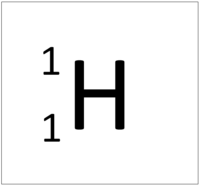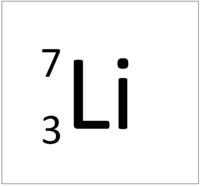Chemical Symbol
Contents
Key Stage 3
Meaning
A Chemical Symbol is a shortened name for an element.
About Chemical Symbols
- Chemical Symbols are used to write Balanced Symbol Equations.
- Most Chemical Symbols use the letters in their name for the symbol but some use letters from their old names. An example of this is Lead which has the symbol Pb because it used to be called 'plumbum'.
Examples
| Hydrogen | Helium | Lithium | Beryllium |
| Hydrogen has the symbol H. The mass number shows there is 1 particle in the nucleus and the atomic number shows that it has 1 proton. | Helium has the symbol He. The mass number shows there are 4 particles in the nucleus and the atomic number shows that it has 2 protons. | Lithium has the symbol Li. The mass number shows there are 7 particles in the nucleus and the atomic number shows that it has 3 protons. | Beryllium has the symbol Be. The mass number shows there are 9 particles in the nucleus and the atomic number shows that it has 4 protons. |
Some unusual symbols you may know:
- Sodium = Na
- Potassium = K
- Iron = Fe
- Tungsten = W
- Silver = Ag
- Gold = Au
- Lead = Pb
- Tin = Sn
- Mercury = Hg
Key Stage 4
Meaning
A Chemical Symbol is a shortened name for an element and how different elements are represented in chemical formulae.
About Chemical Symbols
- Chemical Symbols are used to write chemical formulae and Balanced Symbol Equations.
- Most Chemical Symbols use the letters in their name for the symbol but some use letters from their old names. An example of this is Lead which has the symbol Pb because it used to be called 'plumbum'.
- The chemical symbols of all the elements can be seen on the Periodic Table:
In a chemical formula the chemical symbols are written together with numbers to represent the number of each element in that chemical.
- MgBr2: Magnesium Bromide with one Magnesium atom and two Bromine atoms.
- CO2: Carbon Dioxide with one Carbon atom and two Oxygen atoms.
- Li2O: Lithium Oxide with two Lithium atoms and one Oxygen atom.









